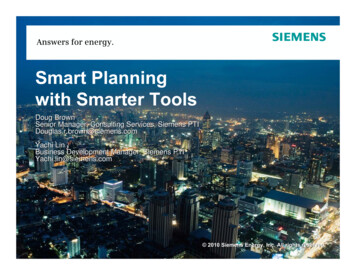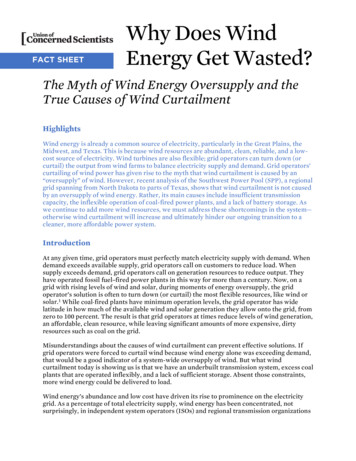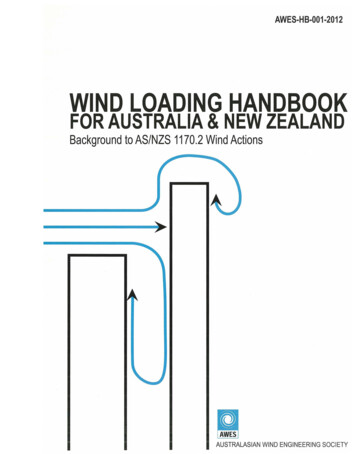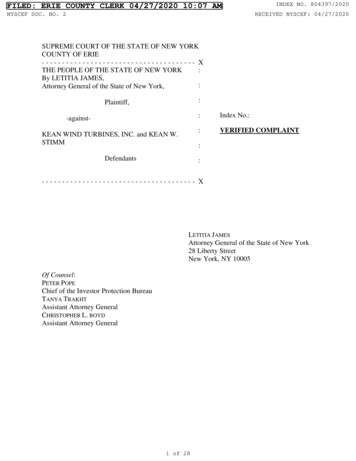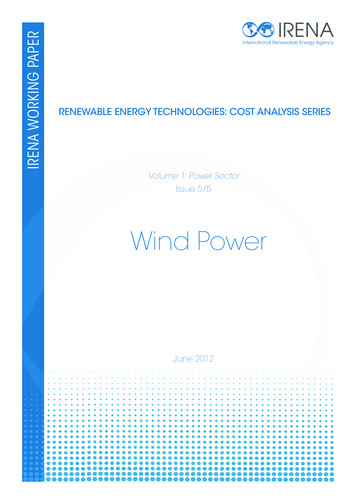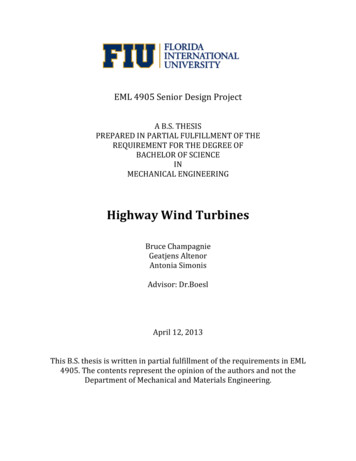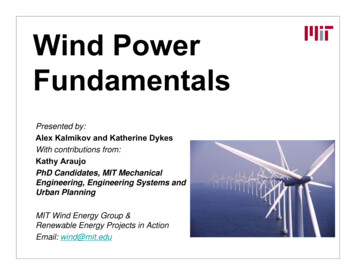
Transcription
Wind PowerFundamentalsPresented by:Alex Kalmikov and Katherine DykesWith contributions from:Kathy AraujoPhD Candidates, MIT MechanicalEngineering, Engineering Systems andU b PlanningUrbanPliMIT Wind Energy Group &Renewable Energy Projects in ActionEmail: wind@mit.edu
Overview History of Wind Power Wind Physics Basics Wind Power Fundamentals Technology Overview Beyond the Science and Technology What’s underway @ MIT
Wind Power in History
Brief History – Early SystemsHarvesting wind power isn’t exactly a newidea – sailing ships, wind-mills, wind-pumps1st Wind Energy Systems– Ancient Civilization in the Near East / Persia– Vertical-Axis Wind-Mill: sails connected to a verticalshaft connected to a grinding stone for millingWind in the Middle Ages– PPostt Mill IIntroducedt dd iin NNorthernthEEurope– Horizontal-Axis Wind-Mill: sails connected to ahorizontal shaft on a tower encasing gears and axlesfor translating horizontal into rotational motionWind in 19th century US– Wind-rose horizontal-axis water-pumpingg wind-millsfound throughout rural AmericaTorrey, Volta (1976) Wind-Catchers: American Windmills of Yesterday and Tomorrow. Stephen Green Press, Vermont.Righter, Robert (1996) Wind Energy in America. University of Oklahoma Press, Oklahoma.
Brief History - Rise of Wind Powered Electricity1888: Charles Brush builds first large-size windgeneration turbine ((17 m diameterelectricityy gwind rose configuration, 12 kW generator)1890s: Lewis Electric Company of New Yorksells generators to retro-fit onto existing windmills1920s 1950s: Propeller-type1920s-1950s:Pll t2 & 3-blade3 bl dhorizontal-axis wind electricity conversionsystems (WECS)1940s – 1960s: Rural Electrification in US andEurope leads to decline in WECS useTorrey, Volta (1976) Wind-Catchers: American Windmills of Yesterday and Tomorrow. Stephen Green Press, Vermont.Righter, Robert (1996) Wind Energy in America. University of Oklahoma Press, Oklahoma.
Brief History –Modern EraKey attributes of this period: Scale increaseCommercializationCompetitivenessGrid integrationCatalyst for progress: OPEC Crisis (1970s) Economics Energy independence Environmental benefitsTurbine Standardization:3-blade UpwindHorizontal-Axison a monopole towerSource for Graphic: Steve Connors, MIT Energy Initiative
Wind Physics Basics
Origin of WindWind – Atmospheric airin motionEnergy sourceSolar radiation differentiallyabsorbedb b dbby earthth surfacefconverted through convectiveprocesses due to temperaturedifferences to air motionSpatialpScalesPlanetary scale: global circulationSynoptic scale: weather systemsMeso scale:Ml localll ttopographichi orthermally induced circulationsMicro scale: urban topographySource for Graphic: NASA / GSFC
Wind types Planetary circulations:– Jet stream– Trade winds– Polar jets Geostrophic winds Thermal winds Gradient winds Katabatic / Anabatic winds – topographic windsBora / Foehn / Chinook – downslope wind stormsSea Breeze / Land BreezeConvective storms / DowndraftsHurricanes/ TyphoonsTornadoesGusts / Dust devils / MicroburstsNocturnal Jets Atmospheric Waves
Wind Resource Availability and VariabilitySource: Steve Connors, MIT Energy InitiativeSource for Wind Map Graphics: AWS Truewind and 3Tier
Fundamentalsof Wind PowerWind Power Fundamentals
Fundamental Equation of Wind Power– WiWinddPPower ddependsd on: amount of air (volume) speed of air (velocity) mass of air (density)flowing through the area of interest (flux)Av– Kinetic Energy definition: KE ½ * m * v 2m& – Power is KE per unit time:& * v2 P ½* mdmmass fluxddt– Fluid mechanics gives mass flow rate(density * volume flux): dm/dt ρ* A * v– Thus: P ½ * ρ * A * v3 Power cube of velocity Power air density Power rotor swept area A πr 2
Efficiency in Extracting Wind PowerBetz Limit & Power Coefficient: Power Coefficient, Cp, is the ratio of power extracted by the turbineto the total contained in the wind resource Cp PT/PW Turbine power outputPT ½ * ρ * A * v 3 * Cp The Betz Limit is the maximal possible Cp 16/27 59% efficiency is the BEST a conventional wind turbine can do inextracting power from the wind
Power Curve of Wind TurbineCapacity Factor (CF): The fraction of the year the turbine generator is operating atrated (peak) powerCapacity Factor Average Output / Peak Output 30% CF is based on both the characteristics of the turbine and thesite characteristics (typically 0.3 or above for a good site)Power Curve of 1500 kW TurbineWind Frequency Distribution0.120.10.080.060.040.020 acitywind speed (m/s)
Lift and Drag Forces
Wind Power Technology
Wind Turbine AlAlmostt allll electricall t i l power on EEarthth iis produceddd withith a tturbinebi off some ttype Turbine – converting rectilinear flow motion to shaft rotation through rotating airfoils³³³³³³³Type ofCombustionGGenerationtiTTypeTraditional BoilerExternalFluidized BedExternalCombustionIntegrated GasificationBothCombined-CycleCombustion TurbineInternalCombined CycleBothNuclearDiesel GensetInternalMicro-TurbinesInternalFuel CellsHydropowerBiomass & WTEExternalWindpowerPhotovoltaicsSolar ThermalGeothermalWave PowerTidal PowerOcean ThermalSource: Steve Connors, MIT Energy InitiativeTurbine TypeGasSteam Water Aero terGeneratorGeneratorGeneratorGeneratorGenerator
Wind Turbine TypesHorizontal-Axis – HAWT Single to many blades - 2, 3 most efficientUpwind downwind facingUpwind,Solidity / Aspect Ratio – speed and torqueShrouded / Ducted – Diffuser AugmentedWind Turbine (DAWT)Vertical-Axis – VAWT Darrieus / Egg-Beater (lift force driven) Savonius (drag force driven)Photos courtesy of Steve Connors, MITEI
Wind Turbine Subsystems–––––FoundationTowerNacelleHub & RotorDrivetrain– Gearbox– Generator– Electronics & Controls––––––YawPitchBrakingPower ElectronicsCoolingDiagnosticsSource for Graphics: AWEA Wind Energy Basics, http://www.awea.org/faq/wwt basics.html
Foundations and Tower Evolution from truss (early 1970s) to monopole towers Many different configurations proposed for offshoreImages from National Renewable Energy Laboratory
Nacelle, Rotor & Hub Main Rotor Design Method (idealcase):1 Determine basic configuration:1.orientation and blade number2. take site wind speed and desiredpower output3. Calculate rotor diameter (accountingfor efficiency losses)4 Select tip-speed4.tip speed ratio (higher Æmore complex airfoils, noise) andblade number (higher efficiency withmore blades)5. Design blade including angle ofattack, lift and drag characteristics6 Combine with theory or empirical6.methods to determine optimumblade shapeGraphic source Wind power: http://www.fao.org/docrep/010/ah810e/AH810E10.htm
Wind Turbine Blades Blade tip speed: 2-Blade Systems andTeetered Hubs: ur/wres/index.htm
Electrical Generator Generator:– Rotating magnetic field induces current Synchronous / Permanent Magnet Generator– Potential use without gearbox– HistoricallyHi t i ll hihigherh costt ((use off rare-earthth metals)t l ) Asynchronous / Induction Generator– Slipp ((operationpabove/below synchronousyspeed)p)ppossible– Reduces gearbox wearMasters, Gilbert, Renewable and Efficient Electric Power Systems, Wiley-IEEE Press, enpoles.htm .
Control Systems & Electronics Control methods– Drivetrain Speed Fixed (direct grid connection) andVariable (power electronics forindirect grid connection)– Blade Regulation Stall – blade position fixed, angleoff attacktt k increasesiwithith windi dspeed until stall occurs behindblade Pitch – blade position changeswith wind speed to activelycontrol lowlow-speedspeed shaft for amore clean power curve
Wind Grid Integration Short-term fluctuations and forecast error Potential solutions undergoing research:– GridG id IIntegration:ttiTransmissionTi i Infrastructure,I f t tDemand-Side Management and AdvancedControls– Storage:Sflywheels,fcompressed air, batteries,pumped-hydro, hydrogen, vehicle-2-grid (V2G)12000W ind Production in MW1100010000900080007000Wind ForecastReal Wind ProductionWind Market Program60005000400010:011 0:12 00:013 0:14 00:015 0:16 00:17 00:018 0:19 00:020 0:21 00:022 0:23 00:000:01: 0002:03: 0004:05: 006: 0007:08: 0009:003000Left graphic courtesy of ERCOTRight graphic courtesy of RED Electrica de EspanaTime 23-24/01/2009
Future Technology Development Improving Performance:– Capacity: higher heights, larger blades, superconductingmagnets– Capacity Factor: higher heights, advanced control methods(individual pitch, smart-blades), site-specific designs Reducing Costs:– Weight reduction: 2-blade designs, advanced materials, directdrive systemsy– Offshore wind: foundations, construction and maintenance
Future Technology Development Improving Reliability and Availability:– Forecasting tools (technology and models)– Dealing with system loads Advanced control methods, materials, preemptivediagnostics and maintenance– Direct drive – complete removal of gearbox Novel designs:– Shrouded,Shrouded floating,floating direct drivedrive, and high-altitude conceptsSky Windpower
Goingg Beyondythe Science &Technology of Wind Source: EWEA, 2009
Wind Energy CostsSource: EWEA, 2009
% Cost Share of 5 MW Turbine ComponentsSource: EWEA, 2009, citing Wind Direction, Jan/Feb, 2007
Costs -- Levelized ComparisonReported in US DOE. 2008 Renewable Energy Data Book
Policy Support HistoricallyUS federal policy for wind energy– Periodic expirationpof Production Tax Credit ((PTC)) in 1999,,2001, and 2003– 2009 Stimulus package is supportive of wind power– Energy and/or Climate Legislation?240019001400900US1Wiser,DenmarkR and Bolinger, M. (2008). Annual Report on US Wind Power: Installation, Cost, and Performance Trends.US Department of Energy – Energy Efficiency and Renewable Energy [USDOE – -10019834001981PTC ExpirationsDelta-Generaation Capacity [MWW]Annual Change in Wind Generation Capacity for US
Policy Options Available Feed-in Tariff GuaranteedGt d MarketsM k t (Public(P bli lland)d) National Grid Development Carbon Tax/Cap and TradeOthers: Quota/Renewable Portfolio Standard Renewable Energy Credits (RECs)/Green Certificates Production Tax Credit (PTC) Investment Tax Credit (ITC)
CommunitiesQuestion: At the urban level, do we apply the same level of scrutinyto flag and light poles, public art, signs and other power plants as we dowindi d tturbines?bi?Considerations: Jobs and industry development; sound and flicker;ChChangingi viewsi((physicalh i l & conceptual);t l) IIntegratedtt d planning;liCambridge, MAGraphics Source: Museum of Science Wind Energy Lab, 2010
The Environment Cleaner air -- reduced GHGs, particulates/pollutants,waste; minimized opportunity for oil spills, naturalgas/nuclear plant leakage; more sustainable effects Planning related to wildlife migration and habitats Life cycle impacts of wind power relativeto other energy sources Some of the most extensive monitoringhas been done in Denmark– finding post-installation benefits Groups like Mass Audubon,Natural Resources Defense Council,World Wildlife Fund support wind powerprojects like Cape WindGraphic Source: Elsam Engineering and Enegi and Danish Energy Agency
What’s underway at MIT MITTurbine Photo Source: uctphotos.php
MIT Project Full Breeze 3 and 6 months of data attwo sites on MIT’s Briggs Field Complemented with statisticalanalysis using MeasureCorrelate-Predict method Research project usingComputational FluidDynamics techniquesfor urban windapplications Published paper atAWEA WindPower2010 conference inTexasAnalysis MethodHeight [m]Mean Wind Speed [m/s]Power Density [W/m 2]Annual Energy Output[kW-hr][kWhr]Annual Production CFD[kW-hr]Capacity FactorOperational TimeAnalysis MethodHeight [m]Mean Wind Speed[m/s]Power Density [W/m 2]Annual Energy Output[kW-hr]Annual ProductionCFD [kW-hr]Capacity FactorOperational TimeMet station n/a1,136n/a1,328n/a1,5585%38%6%28%n/a7%n/a30%Met station an/a7%32%
Spatial Analysis of Wind Resource at MIT
3D model of MIT campus
3D simulations of wind resource structure at MITWind speed(a)(b)(c)(d)Turbulence intensity
Wind Power Density at MITWindPowerDensity(W/m2)WindPowerDensity(W/m2)
Q&ATHANK YOUOU
Jan 24, 2009 · Wind in 19th century US – Wind-rose horizontal-axis wate r-pumping wind-mills found throughout rural America Torrey, Volta (1976) Wind-Catchers: American Windmills of Yesterday and Tomorrow. Stephen Green Press, Vermont. Righter, Robert (1996) Wind E

